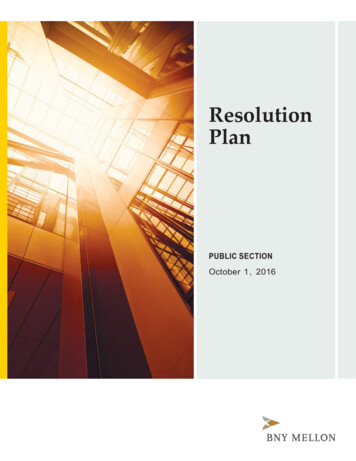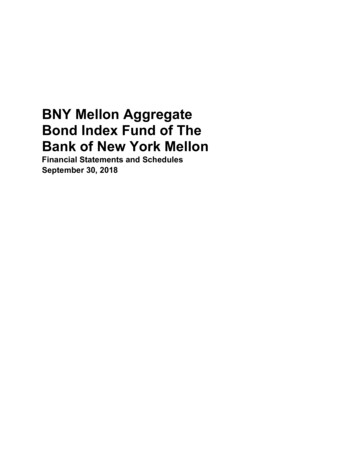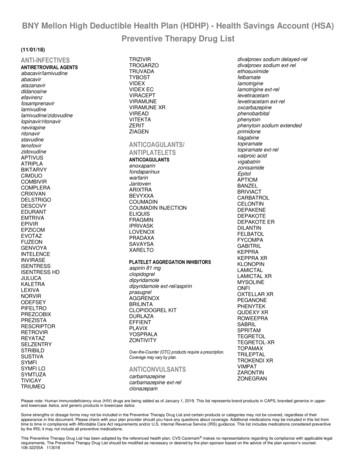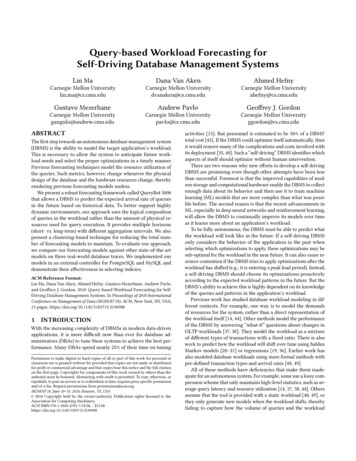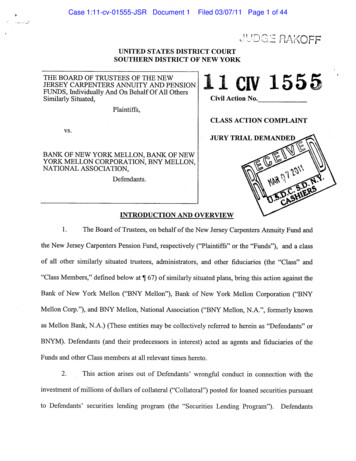
Transcription
BNY Mellon Resolution PlanPublic SectionJuly 1, 2014
Table of ContentsSection 1: Public Section . 3Introduction . 3Overview of BNY Mellon . 5A. Names of Material Entities . 7B. Description of Core Business Lines . 8C. Summary of Financial Information Regarding Assets, Liabilities, Capital and Major Funding Sources . 9D. Description of Derivative and Hedging Activities. 15E. Memberships in Material Payment, Clearing and Settlement Systems . 17F. Description of Foreign Operations . 18G. Material Supervisory Authorities . 19H. Principal Officers. 21I. Resolution Planning Corporate Governance Structure and Processes. 22J. Description of Material Management Information Systems . 23K. High-Level Description of Resolution Strategy . 242
Section 1: Public SectionIntroductionThis Public Section provides an overview of the overall resolution strategy for The Bank of New YorkMellon Corporation and its material entities, including its principal bank subsidiary, The Bank of NewYork Mellon. References to “our,” “we,” “us,” and “BNY Mellon,” refer to The Bank of New York MellonCorporation and its consolidated subsidiaries, while references to the “Parent” refer solely to The Bankof New York Mellon Corporation, the parent company.Title I, Section 165(d) of the Dodd-Frank Wall Street Reform and Consumer Protection Act (the “DoddFrank Act”) and implementing regulations issued by the Federal Deposit Insurance Corporation (the“FDIC”) and the Board of Governors of the Federal Reserve System (the “Federal Reserve”) require bankholding companies with assets of 50 billion or more, such as the Parent, to submit periodically to theFederal Reserve, the FDIC and the Financial Stability Oversight Council a plan for resolution in the eventof material distress or failure of the bank holding company. The FDIC has also issued a final rule thatrequires insured depository institutions with assets of 50 billion or more, such as The Bank of New YorkMellon, to submit periodically to the FDIC a plan for resolution in the event of failure under the FederalDeposit Insurance Act (the “FDI Act”). Accordingly, we have developed a resolution plan in conformitywith both rules (the “Resolution Plan”), including this Public Section which contains the informationrequired by the regulators to be made available publicly.BNY Mellon endorses the concept of resolution planning as a key element of risk management toprotect the soundness of the global financial system. We believe no firm should be “too big to fail” andthat, regardless of size, financial institutions should be able to be resolved without taxpayer or U.S.government support.BNY Mellon’s business model is primarily fee-based with no substantial exposure to credit risk. A largepercentage of our revenue—more than the median revenue of our peers—comes from recurring fees.This helps us maintain a strong, highly liquid balance sheet with a solid capital position and strong creditratings.In the unlikely event a resolution of BNY Mellon were necessary, there are several factors thatcontribute to the resolvability of BNY Mellon under the U.S. Bankruptcy Code and other applicableinsolvency regimes, including the facts that (i) the bulk of BNY Mellon’s core business lines and criticaloperations are conducted in The Bank of New York Mellon, which would allow the FDIC to use itstraditional resolution powers in receivership under the FDI Act to facilitate the orderly disposition orwind down of The Bank of New York Mellon, (ii) the core business lines and critical operationsconducted through non-bank entities of BNY Mellon are largely self-contained within separate legalentities, allowing for their rapid divestiture or orderly wind-down, if necessary, under the U.S.Bankruptcy Code, and (iii) our highly liquid balance sheet would allow us to withstand deposit run-offwithout systemic impact.3
The Resolution Plan sets out a detailed description of the resolution options for the Parent and each ofits material entities, including The Bank of New York Mellon, with a focus on ensuring their orderlyresolution in a manner that preserves value, ensures continuity of services, and avoids systemic risk tothe U.S. financial system. In each of the resolution strategies, depositors would have timely access totheir insured deposits and there would be no cost to the FDIC Deposit Insurance Fund.While BNY Mellon could similarly be resolved without systemic impact under the Orderly LiquidationAuthority of Title II of the Dodd-Frank Act, pursuant to which the FDIC is granted the power andauthority to resolve systemically important financial institutions in a manner analogous to the resolutionof failed insured depository institutions under the FDI Act, the Dodd-Frank Act implementing regulationsspecifically require the Resolution Plan to provide a strategic analysis of resolvability under the U.S.Bankruptcy Code and certain other applicable insolvency regimes. Accordingly, the Orderly LiquidationAuthority is outside the scope of the Resolution Plan.The information contained in the Resolution Plan, including this Public Section, has been prepared inaccordance with applicable regulatory requirements and guidance. Any differences in the presentation ofinformation concerning our businesses and operations contained herein relative to how BNY Mellonpresents such information for other purposes is solely due to our efforts to comply with the rulesgoverning the submission of resolution plans. The information presented herein, including thedesignation of “material entities” and “core business lines”, does not, in any way, reflect changes to ourorganizational structure, business practices or strategy.4
Overview of BNY MellonThe Bank of New York Mellon Corporation, a Delaware corporation (NYSE symbol: BK), is a globalinvestments company dedicated to helping its clients manage and service their financial assetsthroughout the investment lifecycle. Whether providing financial services for institutions, corporationsor individual investors, BNY Mellon delivers informed investment management and investment servicesin 35 countries and more than 100 markets.The Parent was formed as a bank holding company and has its executive offices in New York, New York.With its predecessors, BNY Mellon has been in business since 1784.We divide our businesses into two principal segments, Investment Management and InvestmentServices.Our Investment Management business is comprised of our affiliated investment managementboutiques, wealth management business and global distribution companies. Our InvestmentManagement business is responsible, through various subsidiaries, for institutional, intermediary,retirement and retail investment management, distribution and related services across North America,EMEA and Asia-Pacific. The investment management boutiques offer a broad range of equity, fixedincome, cash and alternative/overlay products. We are one of the world’s largest asset managers with atop-10 position in the U.S., Europe and globally. Through BNY Mellon Wealth Management, we offer afull array of investment management, wealth and estate planning and private banking solutions to helpclients protect, grow and transfer their wealth. We provide these services through an extensive networkof offices in the U.S. and select locations around the world. Clients include high-net-worth individualsand families, family offices, charitable gift programs, endowments and foundations.Our Investment Services business provides global custody and related services, broker-dealer services,global collateral services, corporate trust and depositary receipt and clearing services, as well as globalpayment/working capital solutions to global financial institutional clients. Our clients includecorporations, public funds and government agencies, foundations and endowments; global financialinstitutions including banks, broker-dealers, asset managers, insurance companies and central banks;financial intermediaries and independent registered investment advisors; and hedge fund managers. Wehelp our clients service their financial assets through a network of offices and operations centers in 35countries across six continents.Additional information related to BNY Mellon is contained in BNY Mellon’s reports filed with theSecurities and Exchange Commission (the “SEC”), including our Annual Report on Form 10-K for the yearended December 31, 2013 (which contains the Annual Report to Shareholders (the “2013 AnnualReport”) included with the 10-K) (the “2013 Form 10-K”), the Quarterly Reports on Form 10-Q and theCurrent Reports on Form 8-K (each, a “‘34 Act Report”). These ‘34 Act Reports can be viewed, as theybecome available, on the SEC’s website at www.sec.gov and at www.bnymellon.com. Informationcontained in ‘34 Act Reports that BNY Mellon makes with the SEC subsequent to the date of filingsreferenced in this document, including the 2013 Form 10-K, may modify, update and supersede suchinformation contained in this document.5
Unless otherwise indicated, the information in this document concerning BNY Mellon’s assets, liabilities,capital and funding sources contained in Section C below has been extracted from the 2013 AnnualReport. Such information speaks only as of the date of the 2013 Annual Report. Unless otherwiseindicated, all other information is as set forth in our quarterly report on Form 10-Q for the period endedMarch 31, 2014.This document and BNY Mellon’s ‘34 Act Reports referred to above contain forward-looking statementswithin the meaning of the Private Securities Litigation Reform Act of 1995. Words such as “estimate,”“forecast,” “project,” “anticipate,” “confident,” “target,” “expect,” “intend,” “seek,” “believe,” “plan,”“goal,” “could,” “should,” “may,” “will,” “strategy,” “opportunities,” “trends” and words of similarmeaning, signify forward-looking statements. These statements are based on the current beliefs andexpectations of BNY Mellon’s management and are subject to significant risks and uncertainties that aresubject to change based on various important factors (some of which are beyond BNY Mellon’s control).Actual results may differ materially from those set forth in the forward-looking statements. Factors thatcould cause BNY Mellon’s actual results to differ materially from those described in the forward-lookin
retirement and retail investment management, distribution and related services across North America, . The following businesses are deemed "core business lines"2 for purposes of the Resolution Plan: Asset Servicing BNY Mellon Asset Servicing offers clients worldwide a broad spectrum of specialized asset servicing capabilities, including .
